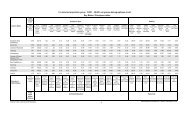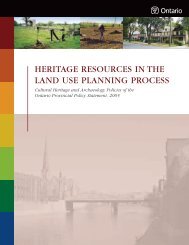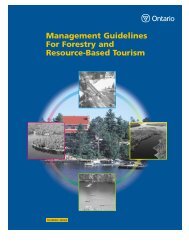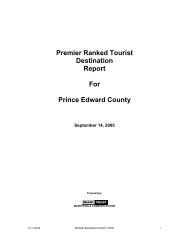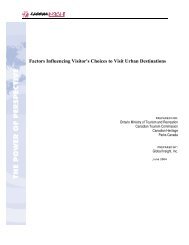Forest Operations on Crown Land - Ministry of Tourism
Forest Operations on Crown Land - Ministry of Tourism
Forest Operations on Crown Land - Ministry of Tourism
- No tags were found...
Create successful ePaper yourself
Turn your PDF publications into a flip-book with our unique Google optimized e-Paper software.
shorelines), test pitting is required asfollows:a. space test pits at maximum intervals <strong>of</strong>5 m between 0 and 50 m from thefeature <strong>of</strong> archaeological potentialb. space test pits at maximum intervals <strong>of</strong>10 m between 50 and 150 m from thefeature <strong>of</strong> archaeological potentialc. survey is not required bey<strong>on</strong>d 150 m3. While maintaining standard survey grids asclosely as possible, the c<strong>on</strong>sultantarchaeologist may vary from standardsurvey grids as necessary, based <strong>on</strong>pr<strong>of</strong>essi<strong>on</strong>al judgment. Document andexplain the rati<strong>on</strong>ale for all variati<strong>on</strong>s in theStage 2 report.2. The alternative strategy for test pit survey in areas with complex combinati<strong>on</strong>s <strong>of</strong>archaeological potential recognizes that, in the course <strong>of</strong> surveying areas previouslyidentified as having archaeological potential, the c<strong>on</strong>sultant archaeologist maydetermine that an area c<strong>on</strong>sists <strong>of</strong> a complex combinati<strong>on</strong> <strong>of</strong> land c<strong>on</strong>diti<strong>on</strong>s resultingin small areas <strong>of</strong> archaeological potential intermixed with areas <strong>of</strong> low potential.Examples include small pockets <strong>of</strong> soil scattered throughout a broader bare limest<strong>on</strong>eplain, or dry areas scattered throughout broader wetlands. These small areas <strong>of</strong>archaeological potential must be surveyed, but it may not be possible to maintain aregular test pit grid or provide a precise map <strong>of</strong> all the surveyed areas.From the Standards and Guidelines for C<strong>on</strong>sultant Archaeologists (2011) (Secti<strong>on</strong> 2.1.6):Test pit survey in areas with complex combinati<strong>on</strong>s <strong>of</strong> archaeological potentialStandards1. Survey all parts <strong>of</strong> these areas that are determined to have archaeological potential usingstandard test pit survey intervals. While maintaining standard survey grids as closely as possible, the c<strong>on</strong>sultant archaeologistmay vary from standard survey grids as necessary, based <strong>on</strong> pr<strong>of</strong>essi<strong>on</strong>al judgment.Document and explain the rati<strong>on</strong>ale for all variati<strong>on</strong>s in the Stage 2 report.2. Record surveyed areas and areas <strong>of</strong> low potential not surveyed to the greatest degree <strong>of</strong>precisi<strong>on</strong> possible given the available base mapping. Based <strong>on</strong> pr<strong>of</strong>essi<strong>on</strong>al judgment, the c<strong>on</strong>sultant archaeologist may map an area c<strong>on</strong>tainingcomplex combinati<strong>on</strong>s <strong>of</strong> c<strong>on</strong>diti<strong>on</strong>s as <strong>on</strong>e unit. Where this approach is followed, record thecharacteristics <strong>of</strong> the area through photographs and detailed written field notes (e.g.,percentages <strong>of</strong> different physical features and areas <strong>of</strong> potential, percentages surveyed andnot surveyed, degree <strong>of</strong> variati<strong>on</strong> within the area).Archaeological Assessments for <str<strong>on</strong>g>Forest</str<strong>on</strong>g> <str<strong>on</strong>g>Operati<strong>on</strong>s</str<strong>on</strong>g> <strong>on</strong> <strong>Crown</strong> <strong>Land</strong>s | 8


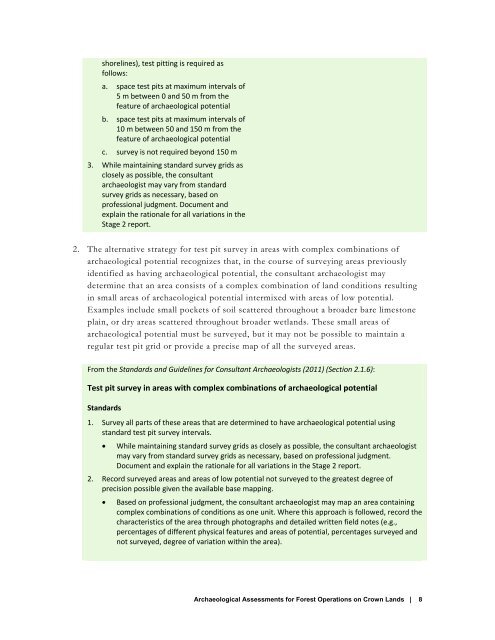
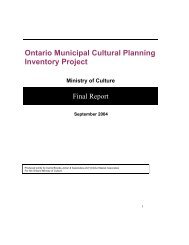
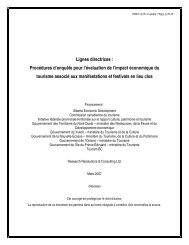
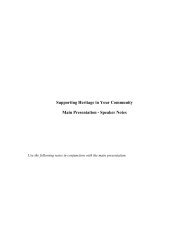
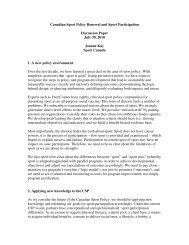
![THIS AGREEMENT made this [date], between [name of owner] (the ...](https://img.yumpu.com/49827605/1/158x260/this-agreement-made-this-date-between-name-of-owner-the-.jpg?quality=85)

